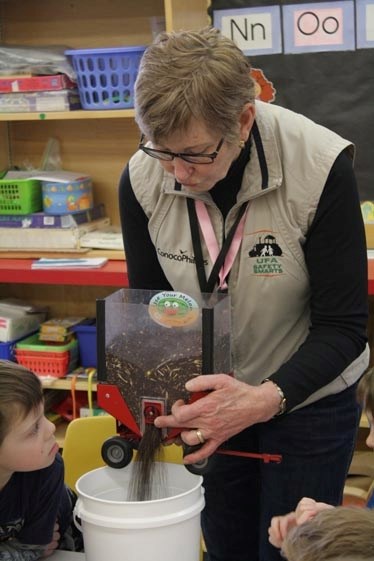While many people view rural life on a farm as quaint and carefree, there are many dangers that can threaten lives and well-being of all members of a farm family.
That was the message given to students at Dunstable School on Feb. 23 when the Alberta Farm Safety Centre’s Shirley Ennis gave a series of presentations outlining different ways children can stay safe on a rural property.
Presentations were geared to the ages in each class, with the messages including “Don’t erase your hearing” for the Grade 3 students and “Don’t cross the stupid line” for the Grade 6 students.
“The idea is that kids don’t always know, so we get them looking for danger,” Ennis said. “We want to get them to think about safety so that as they get older they develop safe practices.”
In order to get the most out of the presentation, the school combined the kindergarten class and its “One seat, one rider” message with the Grade 1 class and its “Use your melon” mantra.
As Ennis led the students through the presentation, she helped them understand that while a farm is a great place to live, there are always dangers that everyone needs to look out for. Part of this was done through a video narrated by Casey the Careful Critter.
In the video, Casey said children need to be wary of livestock, especially females with young. They can spook easily and are unpredictable in their actions.
To illustrate the point, Ennis showed the students a slideshow of a group of cows attacking a bear cub that had wandered into their pen. The cows viewed the cub as a threat, and acted to protect their young. The same thing could happen to a child in a similar situation.
Another caution Casey gave was to stay away from machinery of all kinds. In many cases the machines are large and heavy, and have moving parts that can catch a person’s hair or clothing. There is also the problem of blind spots around especially large machines, where children can disappear from sight, putting them at risk of being run over.
Ennis also presented water as a hazard, one that should only be approached with an adult present. In particular, she said dugouts are dangerous because they often have steep sides and are deeper than people expect.
All this talk of the dangers of farm life is not to scare the kids, Ennis said. Instead, it’s to raise awareness.
“There needs to be someone in every home who is the ‘safety boss,’” she said. “We’re showing them how to recognize hazards.”
The final part of the presentation was to go on a hazard ‘hunt.’ Ennis displayed photos of various scenes that could be found on a rural property and the students pointed out what the dangers were in every scene. In some cases the hazards were obvious, and others were hidden. However, they were all found.
Those hunting skills will be very helpful when the kids go home, she said.
“Kids do a phenomenal job informing their parents,” she said. “If they think something’s wrong, they’re right.”



